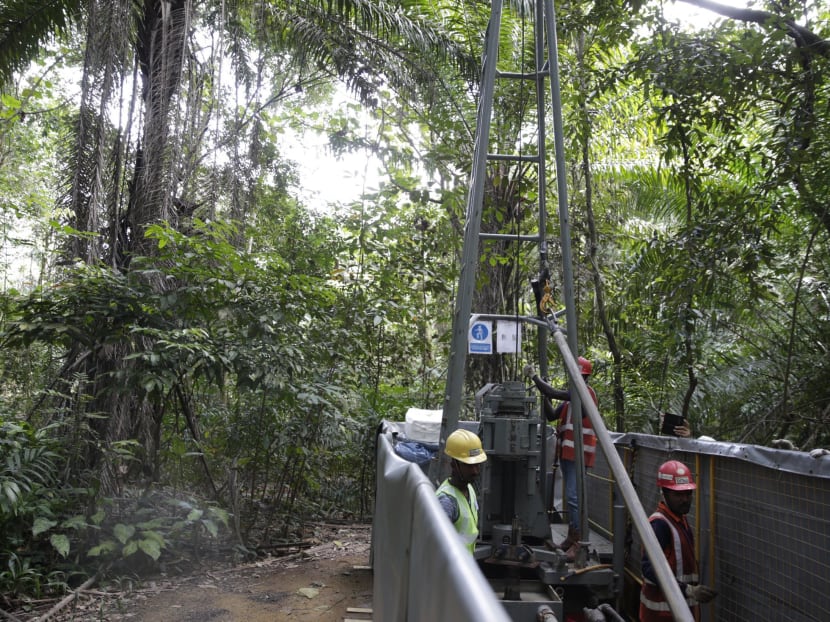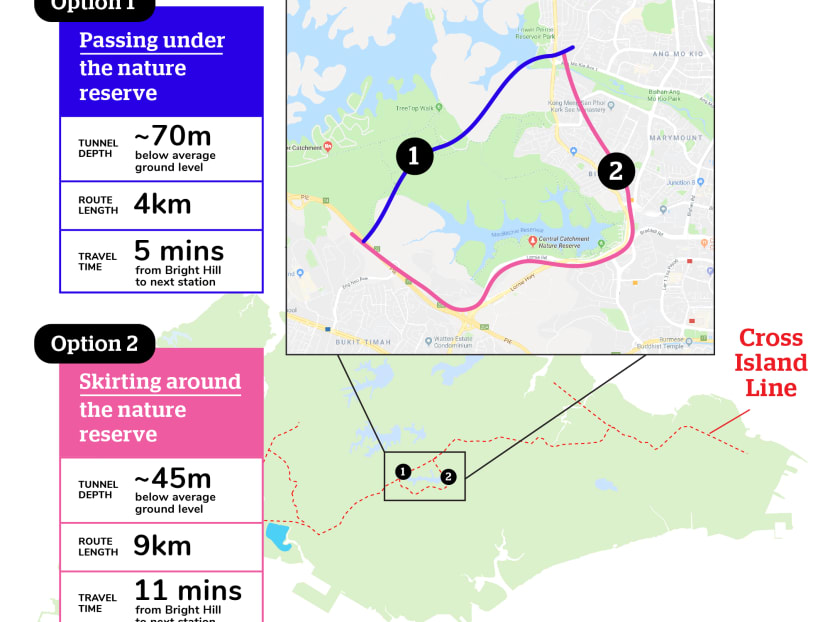Cross Island Line: Environmental impact can be ‘adequately managed’ for both alignment options being considered, study finds
SINGAPORE — The environmental impact of the two underground alignment options for the Cross Island Line (CRL) can be “adequately managed” with comprehensive mitigating measures and monitoring plans.

Site investigation works for the future Cross Island Line being carried out at the Central Catchment Nature Reserve.
SINGAPORE — The environmental impact of the two underground alignment options for the Cross Island Line (CRL) can be “adequately managed” with comprehensive mitigating measures and monitoring plans.
This was the conclusion of the second phase of an environmental-impact assessment on the potential effects from building and running the MRT line for both alignment options.
The Government had earlier said it is deciding between two alignment options for the CRL — one that runs beneath the Central Catchment Nature Reserve, and another slightly longer route that skirts around the nature reserve, which would cost S$2 billion more (based on a government estimate in 2016) and increase travel time by six minutes.
(Click to enlarge)

On Monday (Sept 2), the Land Transport Authority (LTA) gazetted the report on the assessment and the public has a month to give its feedback.
LTA has said that it will decide on the alignment based on factors such as connectivity, travel times, costs, and the impact on homeowners and the environment.
While the latest environmental-impact assessment will support decision-making on the alignment, LTA stressed that it has not reached a decision yet.
Advanced engineering studies for both alignment options are likely to begin next year, even as construction starts on the first stage of the line from Aviation Park in Changi to Bright Hill. This first phase is expected to be completed by 2029.
The CRL, which will be Singapore’s eighth MRT line, is due to be completed by about 2030.
ABOUT THE STUDY
Environment consultancy Environmental Resource Management (ERM) carried out the second phase of the assessment. It concluded that mitigating measures were expected to reduce the potential impact of construction work.
It ranked the impact assessment based on a matrix comprising a range of indicators: Negligible, minor, moderate, major and critical.
Major impact, for example, means effects of a large magnitude will occur to highly valued or sensitive subjects, including people and flora and fauna. Moderate impact means the effects are “around the existing conditions” or accepted standards, or both. Minor refers to a “noticeable effect”.
OPTION 1: PASSING UNDER THE NATURE RESERVE
On the 4km alignment option that runs beneath the nature reserve, ERM assessed that with mitigating measures, the impact will generally be lowered to moderate or minor, from moderate to critical levels.
These measures, which apply to both alignments, include a 30m buffer for worksites in areas connected to natural streams, wildlife shepherding, and replanting native species after construction works are completed.
There will also be measures specific to the option that tunnels through the nature reserve at about 70m below average ground level, the deepest for an MRT tunnel.
These include monthly water sampling of the stream in Windsor Nature Park, which is linked to the nature reserve, and monitoring vibration at selected locations on the surface before tunnel boring.
The impact is expected to be confined largely to parts of the tunnel alignment and the construction worksites. The direct-alignment option has two worksites away from the nature reserve along Island Club Road and to the west of the reserve.
For example, the residual impact of the direct alignment is expected to be moderate in areas such as:
Loss of vegetation and habitat resources.
Fragmentation of habitats.
Disturbance to wildlife.
Injury or death of wildlife due to more vehicle movements at the worksites.
OPTION 2: SKIRTING AROUND THE NATURE RESERVE
The other alignment option will be 5km longer, given that it skirts around the nature reserve, with three worksites near Lakeview estate, along Lornie Road, and between Adam Drive and the Pan Island Expressway.
Tunnel works will be about 45m below average ground level along the 9km alignment.
Skirting around the nature reserve would also mean commutes between Bright Hill Station in Bishan and the next stop, which has not been disclosed, will take 11 minutes, instead of five if the line were to pass under the nature reserve.
An extra mitigating measure for this alignment option is to document historical and genealogical information of all graves within the worksites and tunnels’ footprint, and within a 15m buffer of its tunnel and one of three worksites.
ERM concluded that there would be “major” residual impact on “visual amenity” for high-rise residents at the worksite near Lakeview estate. This means residents of three high-rise blocks there can see the worksite during the estimated five-and-a-half years of construction.
Impact in other areas, however, is estimated to be moderate or minor.
Those of moderate impact include:
Disturbance due to noise at all above-ground worksites.
Disturbance or health effects from dust generated by earthworks or the movement of construction equipment at the worksites.
Fragmentation of habitats.
Injury or death of wildlife.
NATURE SOCIETY: BOTH OPTIONS ‘FEASIBLE’
The 50 to 60km CRL — which will run fully underground from Jurong to Changi — has been intensely debated since plans for the line were announced in 2013.
Nature enthusiasts, who were first approached by the LTA for discussions in June 2013, were against the rail line cutting under the nature reserve, owing to potential damage to its fragile ecosystems and extensive wildlife.
But Dr Shawn Lum, president of Nature Society (Singapore), a non-profit, told TODAY that based on the latest environmental-assessment report, both options appear feasible and would present minimal impact to biodiversity.
Yet he noted that both alignments would have some immediate impact on the surrounding habitats, where rare species including the Sunda pangolin have been spotted.
The question was how comparable the impact from the two alignments would be, and this was important for those who will eventually decide on the alignment.
“How do we make these environmental-impact-assessment findings as comprehensible to a non-specialist as possible?” asked Dr Lum, who is also a senior lecturer at the Nanyang Technological University’s Asian School of the Environment.
For instance, will the impact on a certain animal species be the same at two worksites, or be greater because of higher sensitivity at one or more of the worksites, he asked.
The key, Dr Lum said, was to present a fair representation of the potential impact, so that the decision-makers will have a “full, holistic” picture of both alignments, while balancing these with other considerations.








